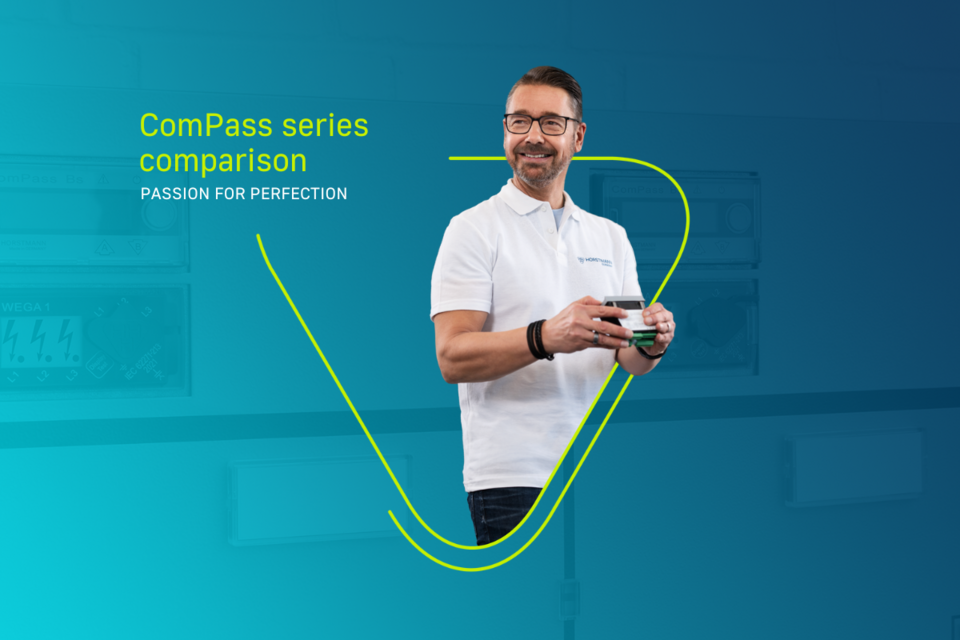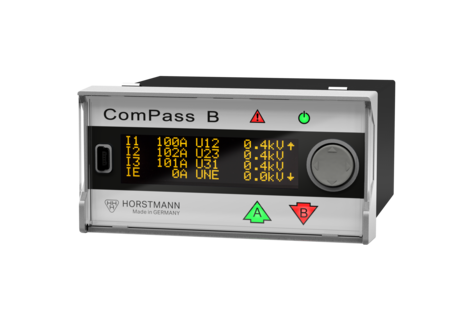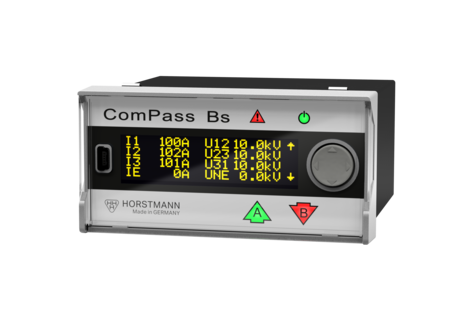Different variants of the ComPass devices

Efficient monitoring: An overview of the different variants of the ComPass series for precise network analysis
Fast troubleshooting in the grid with modern short-circuit and earth fault indicators from Horstmann
Today, increasingly complex power grids with decentralised feed-in points and changing load flow directions prevail. Wind and solar parks and the charging infrastructure for e-mobility as well as heat pumps, battery storage, and electric vehicles in private households must be integrated. Depending on the grid condition and the digitalisation goals, retrofit measures, i.e. the upgrading of a substation by replacing individual components, can be useful.
Relevance and advantages of digital systems in the power grid
Many years of experience have taught us at Horstmann that time is the most important factor for a distribution system operator when it comes to troubleshooting. High-quality and modern short-circuit and earth fault indicators with directional indication and monitoring functionality as well as innovative system solutions are the means of choice for minimising the effort and thus the costs involved in troubleshooting in the medium-voltage grid.
Monitoring increases grid availability and enables predictive maintenance. This enables predictive maintenance measures and anomalies to be detected before faults occur.
The grid becomes transparent - better predictions can be made for further grid planning. The network operator has a full overview of the grid at all times.
Digital products for underground cable networks
Horstmann has developed and established fault indicators for underground cable networks with and without directional indication. These are equally suitable for radial networks, open and closed ring networks, and networks with decentralised feed-in. Regardless of the application, our promise is always: the highest quality - whether for continuous monitoring or in the event of a fault.
In addition to the Sigma family (standard short-circuit and earth fault indicators for networks with low-ohmic neutral point treatment) and the Sigma D family, as short-circuit and earth fault indicators with directional indication, we have developed the ComPass series for high-precision network monitoring. In this article, we explain the differences and special features of the ComPass series.
The ComPass series - monitoring for network analysis
When it comes to highly accurate grid monitoring in combination with directional fault indicators, the ComPass series is the ideal solution. The ComPass records the most important grid data and transmits the high-precision measured values to the control centre. For the best overview of the grid. In addition to high-precision current and voltage monitoring, limit value monitoring for U, I, P, Q, T, and remote signalling are also possible. The OLED display enables clear directional fault indication via 2 directional arrow-shaped LEDs (A/B) and good readability on site under all climatic and ambient light conditions.
The series consists of ComPass A, ComPass B 2.0, ComPass Bs 2.0 and ComPass D.
All ComPass 2.0 devices have a USB port on the front. This can be used to configure the device using the ComPass Explorer software. This software offers numerous functions to support the commissioning and management of the device.

ComPass A 2.0
ComPass A 2.0 is the only short-circuit and earth fault indicator in this series without a directional fault indication.
A special feature of this device is that it measures load currents with high precision (with closed-core sensors), shows them on the display, and reports them remotely via the integrated RS485 interface using the Modbus RTU protocol. Current/temperature limit value monitoring and remote signalling are also possible. The OLED display is easy to read on-site under all climatic and ambient light conditions.
Like all other devices in the series, ComPass A 2.0 requires auxiliary voltage in the range of 24-230V AC/DC and has a backup long-term lithium cell.
This device can also be used for troubleshooting earth faults in low-ohmic networks with stubs or open ring networks without decentralised feed-in. ComPass A 2.0 is suitable for networks with low ohmic or isolated neutral points. Possible reset mechanisms are manual/remote reset, automatic or on-service restoration. Network fault events are signalled remotely via 4 relay outputs or the RS485/Modbus RTU interface.

ComPass B 2.0
The ComPass B 2.0 is equipped with a directional transient earth fault detection algorithm. In addition, the devices from
ComPass B 2.0 onwards are suitable for all neutral point treatments (low ohmic, isolated, compensated), has capacitive and resistive voltage coupling (for high-precision monitoring) and all reset mechanisms (manual/remote reset, automatic, on current restoration or on voltage/auxiliary voltage restoration).
In addition to high-precision current and voltage monitoring, limit value monitoring for U, I, P, Q, T, and remote signalling are also possible. The OLED display indicates the direction of the fault using 2 directional arrow-shaped LEDs (A/B) and is easy to read on-site under all climatic and ambient light conditions.
With ComPass B 2.0 and ComPass Bs 2.0, the network fault events are signalled remotely via 4 relay outputs, the RS485/Modbus RTU interface, or read out via the USB connection with the Explorer software.

ComPass Bs 2.0
ComPass Bs 2.0 is a directional short-circuit and earth fault indicator.
As a special feature and in contrast to the ComPass B 2.0, the ComPass Bs 2.0 has an integrated switching function. This enables the motor control of switch-disconnectors and earthing switches to be activated via the 4 remote signalling contacts, which feature a more robust design for this purpose.

ComPass D
ComPass D also has an integrated switching function. A unique feature that distinguishes ComPass D from the other devices is the integrated Ethernet interface, which is primarily designed for the IEC 60870-5-104 protocol and other Ethernet-based protocols. The network fault events are thus signalled remotely via 4 relay outputs, the USB port, or Ethernet/IEC 60870-5-104.
Summary
This blog post deals with the main product differences and utilisation options of the ComPass series. With these devices, you can maintain transparency in modern distribution grids with decentralised feed-in points and changing load flow directions and quickly narrow down the fault location in the event of a fault. The efficient solution is high-quality short-circuit and earth fault indicators with a monitoring function, such as the ComPass series from Horstmann. These enable precise grid analysis, shorten troubleshooting times, and offer benefits such as increased network availability and predictive maintenance.
The ComPass series from Horstmann comprises the different models ComPass A, B 2.0, Bs 2.0, and D with specific functions for precise network analysis.
The ComPass A is a short-circuit and earth fault indicator without fault direction indication, which measures load currents, shows them on the display, and reports them remotely via the integrated RS485 interface using the Modbus RTU protocol. ComPass B 2.0 and ComPass Bs 2.0 have a directional transient earth fault detection algorithm and a USB port on the front for configuration.
As a special feature, the ComPass Bs 2.0 has an integrated switching function. In addition to the earth fault transient detection algorithm and a USB port on the front for configuration, ComPass D also has an integrated switching function and an Ethernet interface for remote signalling, mainly for the IEC 60870-5-104 protocol.
ComPass ensures transparency in distribution networks.
For more information about the individual devices in the ComPass series, please visit our website.